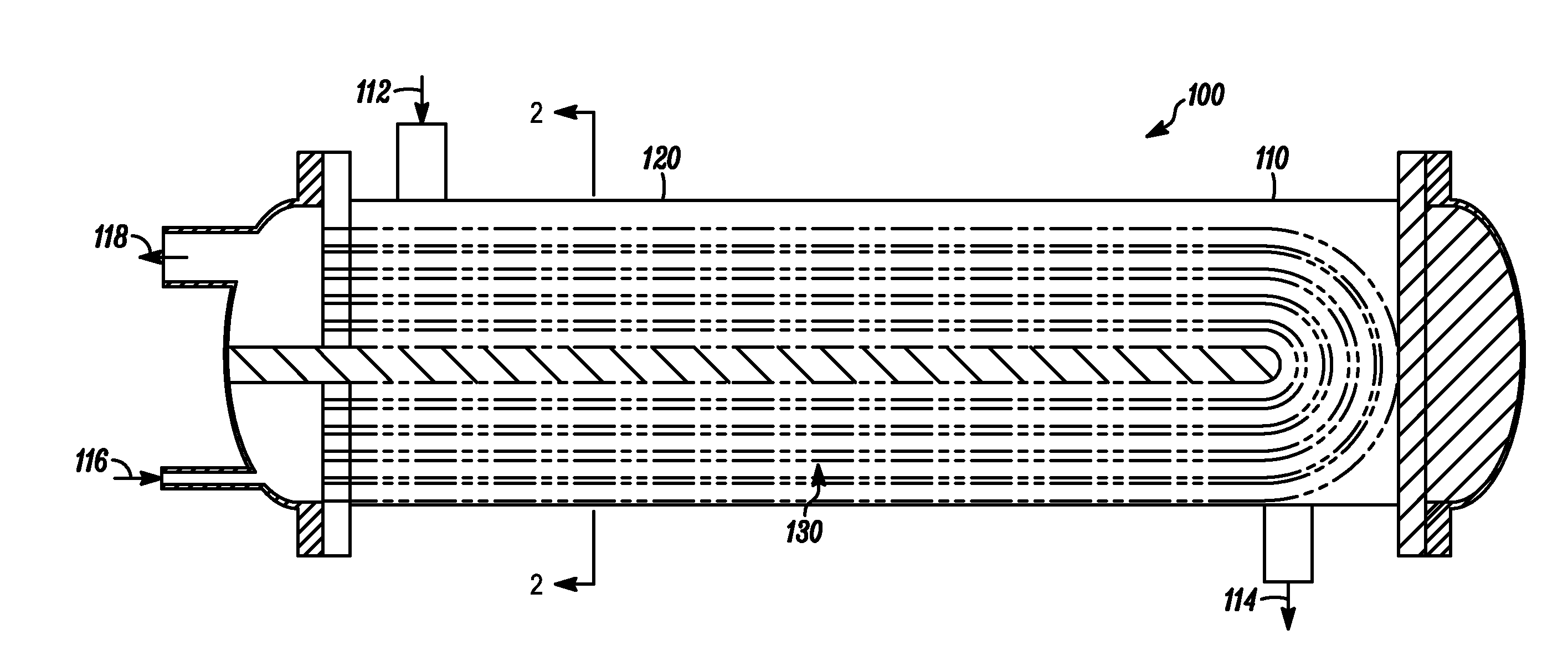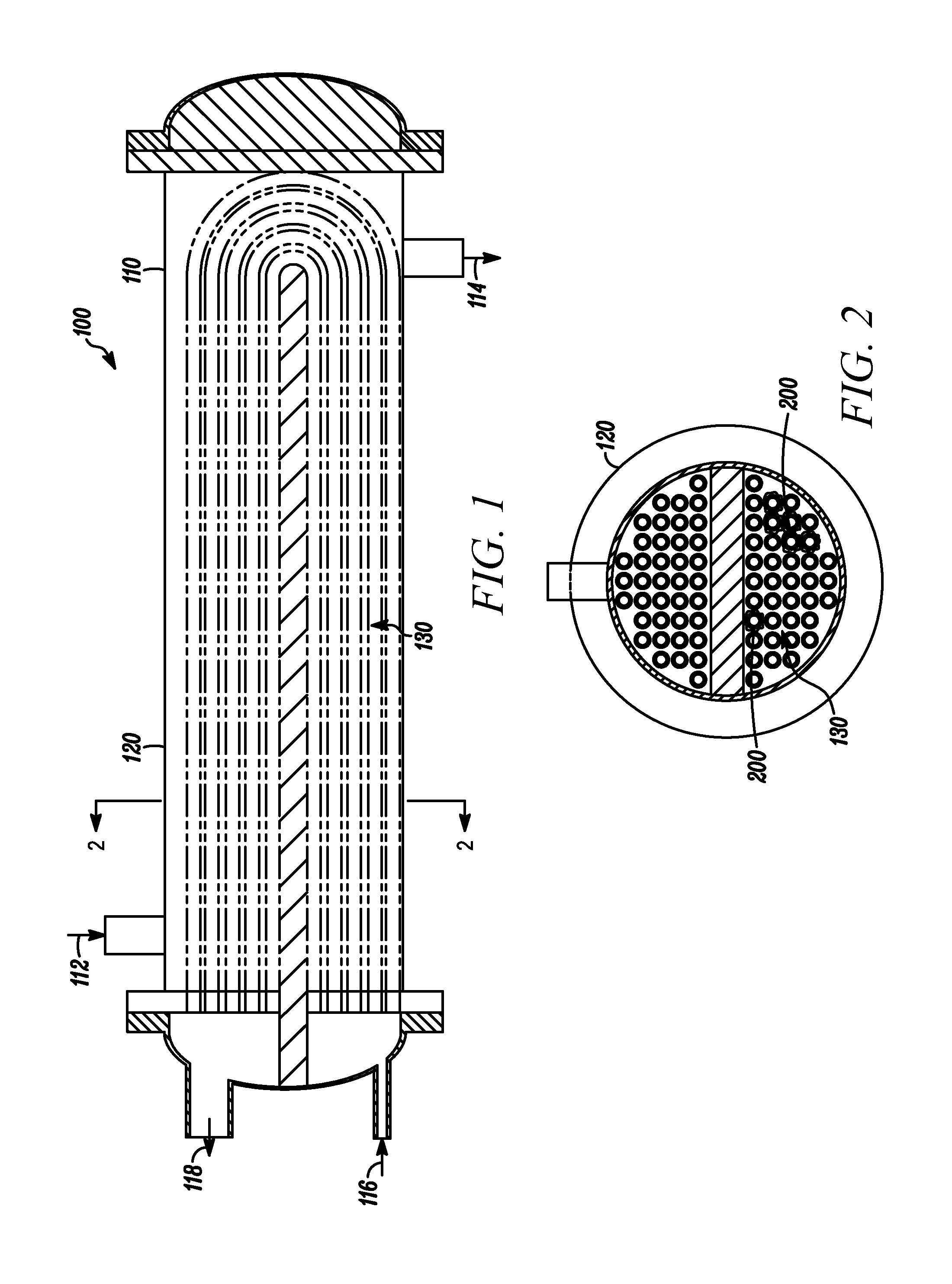Process and composition for removing a scale deposit
a technology of scale deposits and compositions, applied in the direction of detergent compounding agents, liquid soaps, cleaning using liquids, etc., can solve the problems of reducing the heat transfer of equipment, and affecting the cleaning effect of equipment,
- Summary
- Abstract
- Description
- Claims
- Application Information
AI Technical Summary
Benefits of technology
Problems solved by technology
Method used
Image
Examples
example 1
[0028]Various chemicals are applied to a scale deposit that includes in percent, by weight: 37.5 Fe, 8.6 Cr, 4.3 Ni, 1.0 Al, 32.6 S, and 12.5 C, with a remainder of 3.5% of other components. Several solutions are made at room temperature and atmospheric pressure. Solution A is made by adding 0.15 gram citric acid and 0.2 ml of peroxide to 4 ml of water to yield a solution of about 4%, by weight, of citric acid in water. Solution B is a 5%, by volume, of hydrochloric acid in water. Solution C is obtained by adding 0.15 ml of 30%, by weight, hydrogen peroxide to 2 ml of water to yield a solution of about 8%, by weight, hydrogen peroxide. Solution D is obtained by adding nitric acid to Solution C to obtain 11%, by weight, of nitric acid and hydrogen peroxide. Solution E is obtained by adding 0.15 gram ammonium citrate and 0.2 ml of peroxide to 4 ml of water to yield a solution of about 4%, by weight, of ammonium citrate in water. The results are depicted in the table below.
TABLE 1Total...
example 2
[0030]A first composition is made by combining 4 ml of H2O with 2 ml of H2O2 and 0.15 gram ammonium citrate in a first open beaker, and a second composition is made by combining 4 ml of H2O with 2 ml of H2O2 and 0.15 gram citric acid in a second open beaker. Respective quantities of 0.2 gram of the scale deposit of Example 1 are placed into each beaker. The solution is heated to 60° C. for 30 minutes. The scale deposit and solution is centrifuged, and the supernatant is removed and replaced with a fresh solution. The supernatant wash solutions are analyzed by Inductively Coupled Plasma Emission Spectroscopy (ICP) for metals. After four leaches of 30 minutes almost three-fourths of the iron may be dissolved using the ammonium citrate, while only about one-fourth of the iron may be dissolved using citric acid. Results are depicted below.
TABLE 2Percent, By Weight, of Selected Dissolved MetalsAmmonium CitrateCitric AcidLeachFeNiCrFeNiCr#118.1281.27.22.31.1#225.3~1001.25.64.62.2#318.1981...
example 3
[0031]A composition or solution (Solution F) is made by combining 50 ml of H2O, 1.85 gram of ammonium citrate, and 5 ml of H2O2 at 60° C. and is agitated at a rate of 100 agitations per minute. Next, 2.5 gram of the scale deposit of Example 1 is placed into the solution. The initial pH is 5.2 and increases to a pH of 7.2 after 21 hours, and the solution can generate pressure as oxygen evolves. At specified intervals of 21 hours and 45 hours, a sample aliquot is removed and analyzed for iron by ICP and sulfate by ion chromatography (IC) by ASTM D 4327-03 method. After 45 hours, a fresh portion of Solution F is applied to the scale deposit, and a sample of aliquot is removed and analyzed after 24 more hours using the same testing procedures for the samples withdrawn at 21 and 45 hours above. The results are depicted below.
TABLE 3Percent, By Weight, of Dissolved Scale Deposit ComponentsTimeFeNiCrS1. After 21 hours36.532518.12. After 45 hours39.734521.83. New Solution after 24 hours22.1...
PUM
| Property | Measurement | Unit |
|---|---|---|
| pressure | aaaaa | aaaaa |
| temperature | aaaaa | aaaaa |
| pressure | aaaaa | aaaaa |
Abstract
Description
Claims
Application Information
 Login to View More
Login to View More - R&D
- Intellectual Property
- Life Sciences
- Materials
- Tech Scout
- Unparalleled Data Quality
- Higher Quality Content
- 60% Fewer Hallucinations
Browse by: Latest US Patents, China's latest patents, Technical Efficacy Thesaurus, Application Domain, Technology Topic, Popular Technical Reports.
© 2025 PatSnap. All rights reserved.Legal|Privacy policy|Modern Slavery Act Transparency Statement|Sitemap|About US| Contact US: help@patsnap.com


